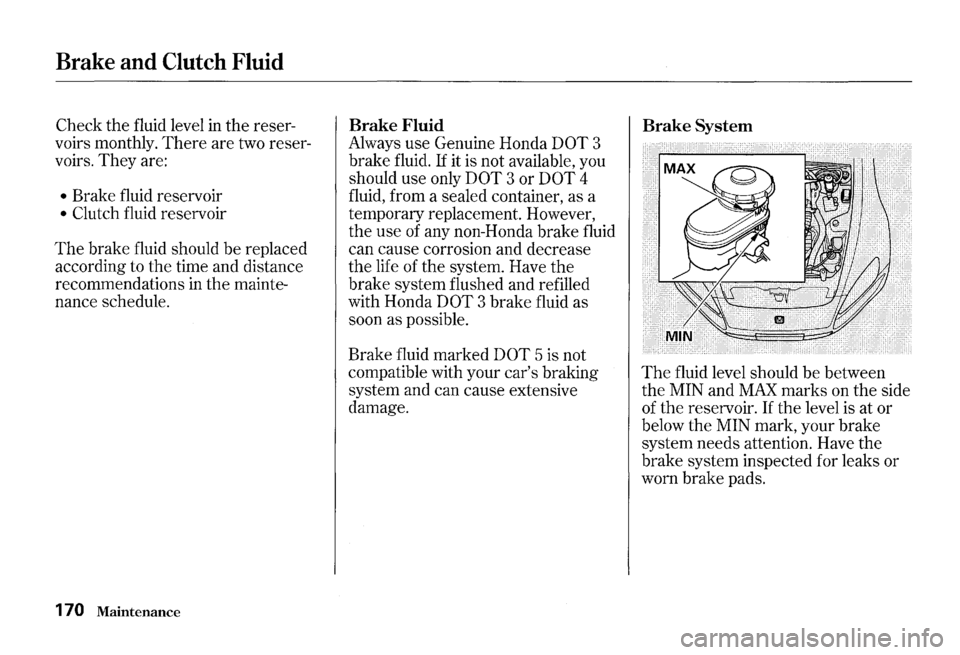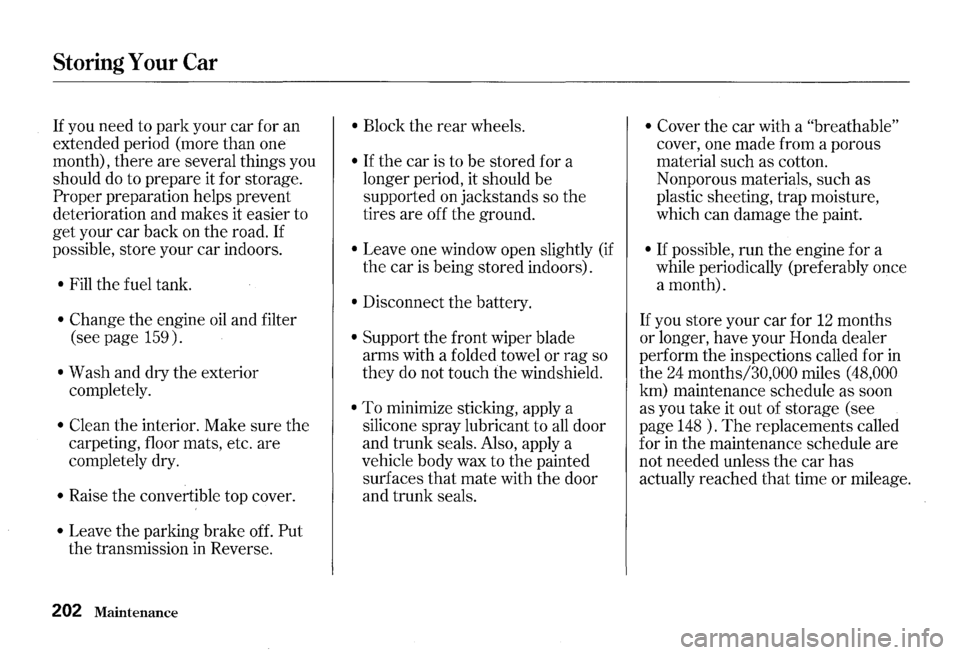Page 173 of 273

Brake and Clutch Fluid
Check the fluid level in the reser
voirs monthly.
There are two reser
voirs.
They are:
• Brake fluid reservoir
• Clutch fluid reservoir
The brake fluid should be replaced
according to the time and distance
recommendations in
the mainte
nance schedule.
170 Maintenance
Brake Fluid Brake System
Always use Genuine Honda DOT 3
brake fluid.
If it is not available, you
should use only
DOT 3 or DOT 4
fluid, from a sealed container, as a
temporary replacement. However,
the use of any non-Honda brake fluid
can cause corrosion and decrease
the life of the system. Have
the
brake system flushed and refilled
with Honda
DOT 3 brake fluid as
soon as possible.
Brake fluid marked
DOT 5 is not
compatible with your car's braking
system and can cause extensive
damage.
The fluid level should be between
the MIN and
MAX marks on the side
of the reservoir. If the level is at or
below the MIN mark, your brake
system needs attention. Have the
brake system inspected for leaks or
worn brake pads.
Page 174 of 273
Clutch System
The fluid should be between the
MIN and
MAX marks on the side of
the reservoir. If it is not, add brake
fluid to bring it up to
that level. Use
the same fluid specified for the
brake system.
Low fluid level can indicate a leak
in
the clutch system. Have this system
inspected as soon as possible.
Clutch Fluid
Maintenance 171
Page 194 of 273

Snow Tires
If you mount snow tires on your
Honda, make sure they are radial
tires of the same size and load range
as
the original tires. Mount snow
tires on
all four wheels to balance
your vehicle's handling in all weather
conditions. Keep
in mind the traction
provided by snow tires on dry roads
may not be as high as your vehicle's
original equipment tires. You should
drive cautiously even when the roads
are clear. Check with the tire dealer
for maximum speed recommenda
tions.
Tire Chains
Because your Honda has limited tire
clearance, mount only
SAE Class "S"
cable-type traction devices on the
rear tires.
Use traction devices only
when required by driving conditions
or local laws. Make sure they are the
correct size for your tires.
Metal link-type
"chains" should not
be used.
No matter how tight they
seem to be installed, they can come
into contact with the body and
suspension, causing serious damage.
When installing
the cables, follow
the manufacturer's instructions and
mount
them as tightly as you can.
Drive slowly with them installed.
If
you hear them coming in contact
with the body or chassis, stop and
investigate. Make sure the cables are
installed tightly, and
that they are
not contacting the brake lines
or
suspension. Remove them as soon as
you start driving on cleared roads.
Tires
NOTICE
Cables that are the wrong size or
improperly installed can damage your ·
car's brake lines, suspension, body, and
wheels. Stop driving (l they are hitting
any part
of the car.
Maintenance 191
Page 196 of 273
Lights
Check the following:
• Headlights (low and high beam)
• Parking lights
• Taillights
• Brake lights
• Turn signals
• Back-up lights
• Hazard light function
• License plate light
• Side marker lights
• Daytime running lights
(Canadian cars)
If you find any bulbs are burned out,
replace
them as soon as possible.
Refer to the chart on page
245 to
determine what type of replacement
bulb is needed.
Maintenance 193
Page 205 of 273

Storing Your Car
If you need to park your car for an
extended period (more than one
month), there are several things you
should
do to prepare it for storage.
Proper preparation helps prevent
deterioration and makes it easier to
get your car back on the road.
If
possible, store your car indoors.
• Fill the fuel tank.
• Change the engine oil and filter
(see page 159).
• Wash and dry the exterior
completely.
• Clean the interior. Make sure the
carpeting, floor mats, etc. are
completely dry.
• Raise the convertible top cover.
• Leave the parking brake off. Put
the transmission in Reverse.
202 Maintenance
• Block the rear wheels.
• If the car is to be stored for a
longer period, it should be
supported on jackstands so the
tires are off the ground.
• Leave one window open slightly (if
the car is being stored indoors).
• Disconnect the battery.
• Support the front wiper blade
arms with a folded towel or rag so
they
do not touch the windshield.
• To minimize sticking, apply a
silicone spray lubricant to
all door
and trunk seals. Also, apply a
vehicle body wax to the painted
surfaces that mate with the door
and trunk seals.
• Cover the car with a "breathable"
cover, one made from a porous
material such as cotton.
Nonporous materials, such as
plastic sheeting, trap moisture,
which can damage
the paint.
• If possible, run the engine for a
while periodically (preferably once
a month).
If you store your car for 12 months
or longer, have your Honda dealer
perform the inspections called for
in
the 24 months/30,000 miles (48,000
km) maintenance schedule as soon
as you take it out of storage (see
page
148 ). The replacements called
for
in the maintenance schedule are
not needed unless the car has
actually reached that time or mileage.
Page 214 of 273

Taking Care of the Unexpected
This section covers the more
common problems
that motorists
experience with their vehicles.
It
gives you information about how to
safely evaluate the problem and what
to
do to correct it. If the problem has
stranded you on the side of the road,
you may be able to get going again.
If not, you will also find instructions
on getting your car towed. Compact
Spare Tire .......................
212
Changing a Flat Tire ..................... 213
If Your Engine Won't Start ........... 218
Nothing Happens or the
Starter Motor
Operates
Very
Slowly ......................... 218
The Starter Operates
Normally ................................. 219
Jump Starting ................................. 220
If Your Engine Overheats ............. 223
Low Oil Pressure Indicator .......... 226
Charging System Indicator.. .........
227
Malfunction Indicator Lamp ........ 228
Brake System Indicator ................ 229
Closing the Convertible Top ........ 230
Fuses ............................................... 231
Checking and Replacing ........... 232
If Your Car Gets Stuck. ................. 236
Emergency Towing ....................... 238
Taking Care of the Unexpected 211
Page 216 of 273

If you have a flat tire while driving,
stop in a safe place to change it.
Stopping in traffic
or on the shoulder
of a busy road is dangerous. Drive
slowly along
the shoulder until you
get to an exit or an area to stop that
is far away from the traffic lanes.
The car can easily roll off the
jack,
seriously injuring anyone
underneath.
Follow the directions for
changing a tire
exactly, and
never get under the car when it
is supported only by the jack.
The compact spare tire is smaller
than a standard tire, which
will affect
the vehicle's handling. Drive
cautiously when this spare is
mounted on your vehicle.
The size difference may also cause
damage to
the rear differential, so do
not mount
the compact spare on the
rear. If either rear tire goes flat,
remove
the front tire on that same
side, mount
the compact spare tire
on
the front, then mount the front
tire on
the rear.
1. Park the car on firm, level, non
slippery ground away from traffic.
Put the transmission in Reverse.
Apply
the parking brake.
2. Turn on the hazard warning lights
and turn
the ignition switch to
LOCK (O). Have your passenger
get out of the car while you
change
the tire.
Changing a Flat Tire
3. Open the trunk. Lift up the tool
box lid and take
the jack, wheel
wrench and extension out of
the
tool box.
NOTICE
Use the jack that came on your car. If
you try to raise another car by this jack
or use another jack to raise your car,
the car
or jack can be damaged.
CONTINUED
Taking Care of the Unexpected 213
Page 223 of 273
Jump Starting
If your car's battery has run down,
you may
be able to start the engine
by using a booster battery. Although
this
seems like a simple procedure,
you should take several precautions.
220 Taking Care of the Unexpected
A battery can explode if you do
not
follow the correct procedure,
seriously injuring anyone
nearby.
Keep
all sparks, open flames,
and smoking materials away
from the battery.
To jump start your car, follow these
directions closely:
1. Open the hood and check the
physical condition of the battery
(see page 177 ) . In very cold
weather,
check the condition of
the electrolyte. If it seems slushy
or like ice, do not
try jump starting
until it thaws.
NOTICE
if a battery sits in extreme cold, the
electrolyte inside can freeze.
Attempting
to jump start with a frozen
battery can cause it
to rupture.
2. Turn off all the electrical acces
sories: heater,
A/C, stereo system,
lights, etc.
Put the transmission in Neutral
and
set the parking brake.